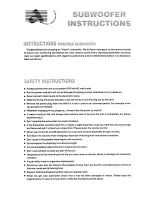
16
| KH 805
X
Calibrate the frequency response, the phase and the acoustical level of the subwoofer .
To do so, choose one of the following methods:
1 . Calibration using an acoustical measurement system
Calibrating the frequency response, phase and sound pressure level by means of an
acoustical measurement system should always be your first choice since it yields the
highest accuracy . This method is described below .
2 . Calibration using Neumann test signals
In the absence of an acoustical measurement system, you can calibrate the settings of
your subwoofer using Neumann test signals (see page 17) .
3 . Calibration using music signals and an 80 Hz test signal
A calibration by means of music signals is also possible but should always be the last
choice . In this case, play an 80 Hz test signal from your source equipment to calibrate
the phase (see page 17) .
If you are using several subwoofers, it is possible that the same setting is not valid for all
subwoofers .
X
Calibrate each subwoofer separately .
However, note that daisy chained subwoofers will track the settings on the first subwoofer
in the daisy chain .
X
If necessary, move the subwoofer and/or the main loudspeakers .
X
If necessary, apply acoustical treatment to the source of any reflections .
Calibration using an acoustical measurement system
The settings of the switch SUBWOOFER GAIN | OUTPUT LEVEL
H
and the potentiometer
SUBWOOFER GAIN | INPUT GAIN
J
recommended in the following
table
are valid for
the following settings of your Neumann loudspeaker: INPUT GAIN: “0 dB” and OUTPUT
LEVEL: “100 dB SPL at 1 m for 0 dBu” . For information on how to set your Neumann
loudspeaker, please refer to its operating manual . If the mentioned values cannot be set
on your loudspeaker, adjust the subwoofer accordingly .
The frequency response of a subwoofer depends on its position in the room and on the room
geometry . The same subwoofer installed in different positions in the same room may require
different acoustical control settings .
X
Adjust the frequency response of the subwoofer at your listening position . To do so, proceed
as follows:
X
Make sure that the switch SUBWOOFER GAIN | OUTPUT LEVEL
H
is set to “100 dB SPL at 1 m
for 0 dBu” .
X
First, set the potentiometers SUBWOOFER GAIN | INPUT GAIN
J
and LOW CUT
9
to the
following settings . These settings can be used as a starting point for further adjustment:
Subwoofer position
Setting of potentiometer
SUBWOOFER GAIN | INPUT GAIN
J
Setting of potentiometer
LOW CUT
9
In a corner
-
8 dB
-
4 dB
Next to or flush
mounted in an
acoustically solid
wall (e .g . brick,
concrete)
-
4 dB
-
2 dB
Next to or flush
mounted in an
acoustically soft
wall (e .g . gypsum)
-
2 dB
0 dB
Free standing in an
untreated room
-
2 dB
0 dB
Free standing in a
well-treated room
0 dB
0 dB
Calibrating the
frequency
response
















































